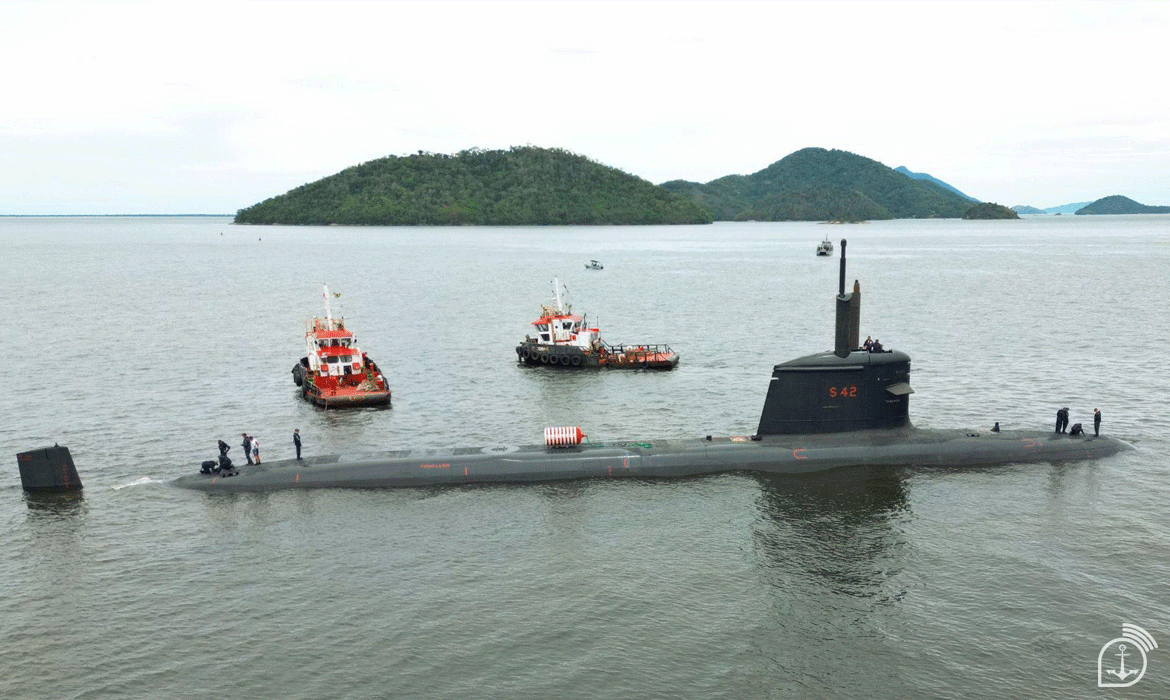The Submarine “Tonelero” (S42) performed its first static immersion last Friday (25), near the Island of Itacuruçá, in Rio de Janeiro (RJ). The procedure aimed to verify the stability of the S42 at sea, both on the surface and under water. The result was considered satisfactory, being essential to proceed with the next stages: tests on the dock and at sea, in order to definitively incorporate the “Tonelero” into the operational sector of the Brazilian Navy (MB).
The Commander of the “Tonelero”, Frigate Captain Eduardo Tavares Santos, linked the success of the mission to the training phase in simulators, which corroborates the full qualification of the military personnel. “As a result of the efforts made throughout the preparation period, the tests went as planned, without incidents”. The Commander also revealed the next steps that the S42 will face. “It is expected that the surface tests will be conducted this year, as the last stage before the Dynamic Immersion, followed by the first battery charge in immersion – using a snorkel to take in air without the need for the submarine to come to the surface to renew it – and by the Deep Dive, where the structural parameters of the submarine’s hull will be analyzed.”
How does static immersion work?
The process involves introducing water, in a controlled manner, into the submarine’s ballast tanks until it is completely submerged, without the use of engines. With the submarine submerged, using movements of weights positioned along the vessel, the platform’s response in terms of increasing inclination angles is observed. From there, it is possible to obtain the transverse and longitudinal stability parameters.
During testing, the volume of water in the internal compensation and trim tanks is also checked. The analyses allow for the precise determination of the submarine’s displacement when submerged.

In the future, other systems and equipment will be installed and commissioned, and another static immersion will be carried out, scheduled for the end of the construction process. This time, the final configuration of weights on board the “Tonelero” will be considered.
“Tonelero” submarine incorporates the modernity of the French-designed Scorpène Class vessels, with adaptations and improvements to meet the specific needs of the Brazilian Navy’s operations. Larger than the original Scorpène model, the “Tonelero” is over 71 meters long and has a submerged displacement of 1,870 tons.
In March of this year, the “Tonelero” was christened and launched into the sea . The event took place at the Itaguaí Naval Complex (RJ) and marked the completion of the construction process of the third Conventional Submarine with Diesel-Electric Propulsion, built entirely in Brazil, within the scope of the Submarine Development Program (PROSUB), the result of a strategic partnership signed in 2008 between Brazil and France, which provides for the transfer of technology in the military-naval area.
In addition to the “Tonelero”, the submarines “Riachuelo” (S40) and “Humaitá” (S41) have already been completed. The delivery of another conventional submarine, previously named “Angostura” (S43), and recently changed to “Almirante Karam” (in memoriam to the former Minister of the Navy, who passed away in September of this year), is also planned, in addition to the construction of the Conventionally Armed Nuclear Submarine, the “Álvaro Alberto” .

